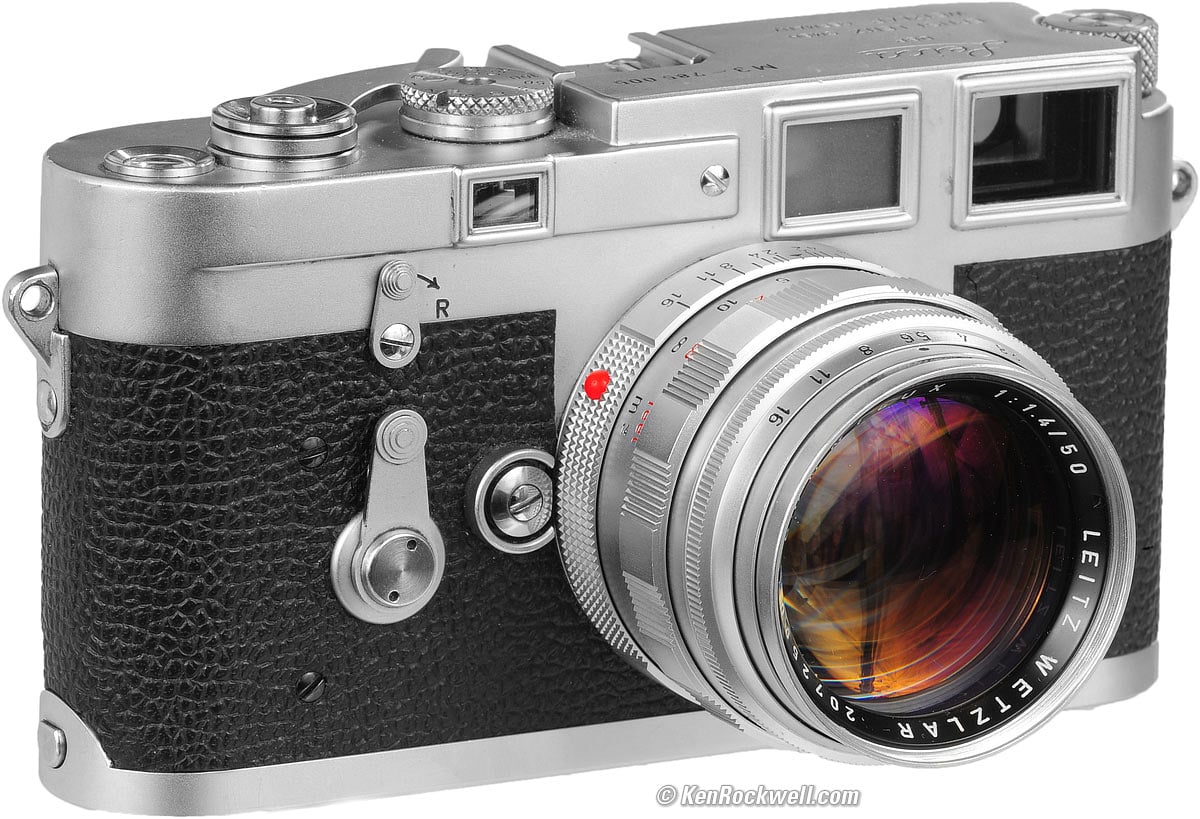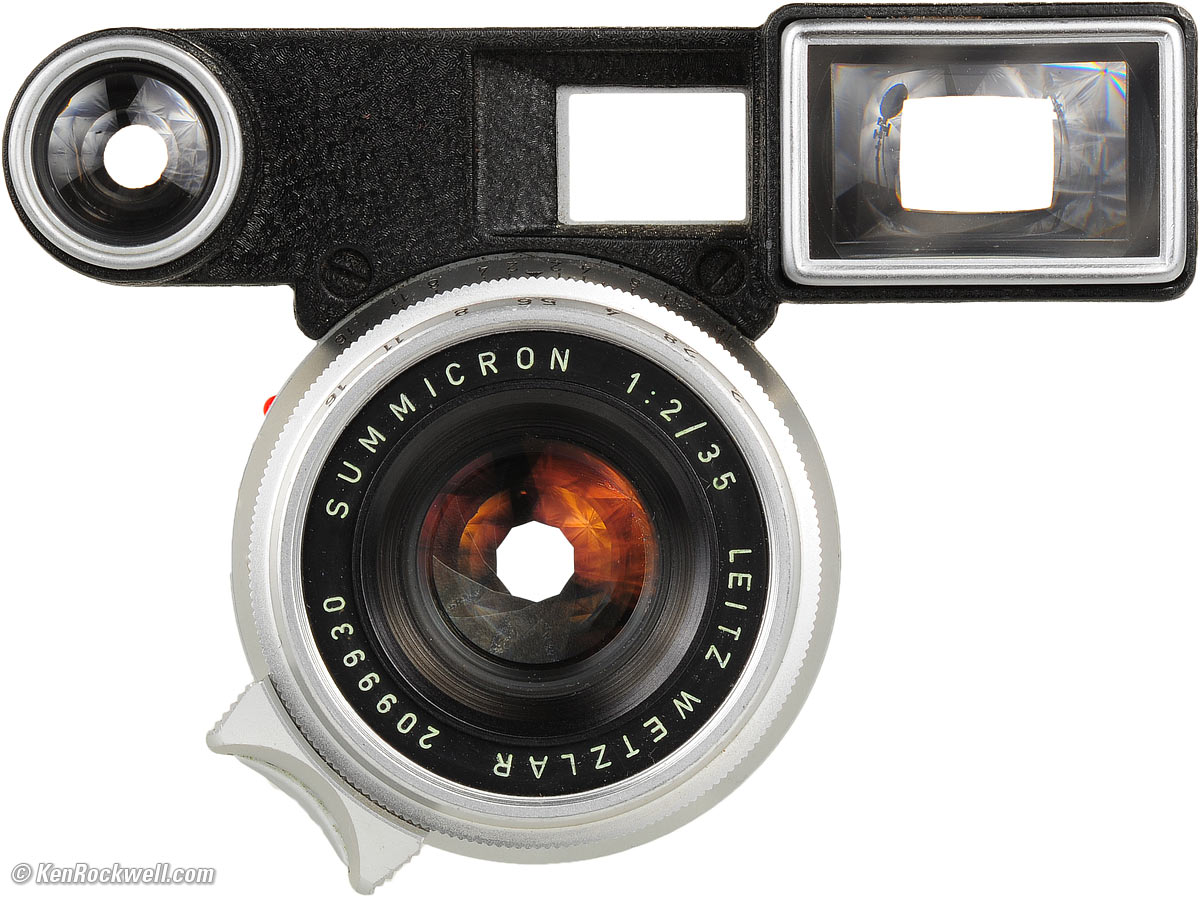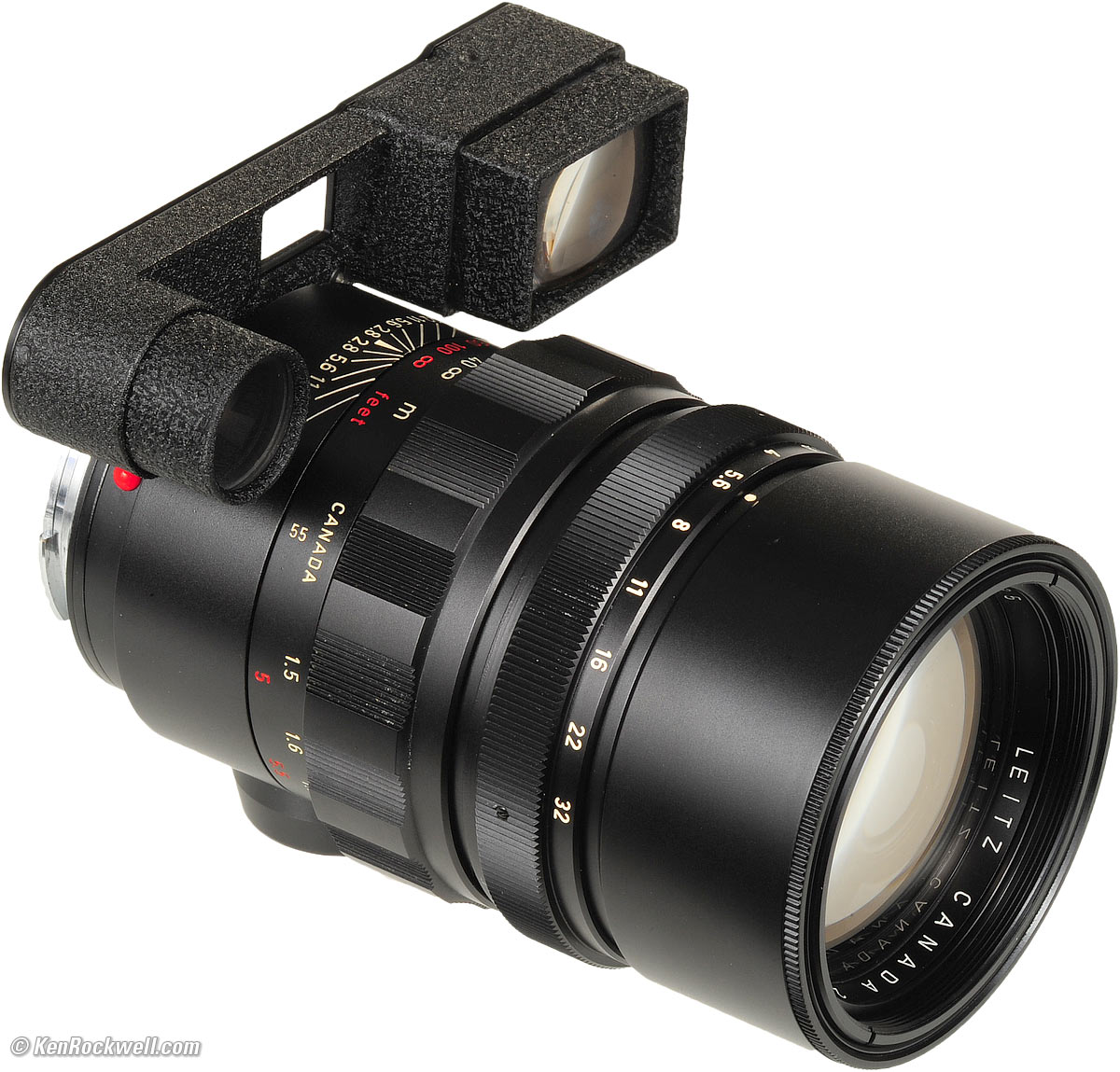LEICA Finder Magnifications
0.58×, 0.68×, 0.72×, 0.85× and 0.91×
LEICA M3: 0.91× finder magnification. enlarge.
This all-content, junk-free website's biggest source of support is when you use any of these links to approved sources when you get anything, regardless of the country in which you live. Thanks for helping me help you! Ken.
December 2022 Better Pictures LEICA Reviews LEICA Lenses All Reviews
Introduction top
|
|
LEICA's first cameras used a separate peephole for the rangefinder, through which one focused, and a second peephole near it for the viewfinder, for framing your photo.
The LEICA M3 of 1954 was their first camera to incorporate the rangefinder spot in the middle of the viewfinder, so you could focus and compose without moving your eye. All rangefinder cameras are made this way today.
LEICA was so proud of this advancement that they named these cameras "M," which stands for Messsucher, meaning "combined range-measuring viewfinder."
LEICA has made M series cameras with four different viewfinder magnifications, three of which are still made today.
Higher magnifications give greater rangefinder (focussing) precision and a bigger finder image, but are not good for wide-angle lenses, whose viewfinder frames get too big to see.
Better cameras, like the Contax G system, have finders which change magnification to optimize themselves to any lens which is mounted. LEICAs can't do this yet.
WIth LEICA, you're stuck with just one magnification that has to serve you for every lens. Depending on the lenses you shoot, you might want to pick a different camera or finder to suit your needs better.
LEICA's best camera, the original M3 shown above, has the highest 0.91× magnification. (0.91× is a little less than life size, so it's actually reduction, not magnification, but we're calling it magnification anyway.)
The M3 is magnificent because this higher magnification allows the most precise rangefinder focusing of any LEICA M, which begets the sharpest images. It's large finder also allows the best viewing for 50mm, 90mm and 135mm lenses.
Viewfinder Adapters (eyes and goggles)
The M3 was so brilliant that even though its finder couldn't zoom to optimize itself for different lenses, some lenses for the M3 came with special permanently-attached viewfinder adapters, also called goggles, eyes or auxiliary viewfinder optics, that optimized the finder magnification for these lenses.
LEICA SUMMICRON 35mm f/2. bigger.
35mm lenses for the M3 came with these two additional 0.7× reducing lenses.
These additional lenses squeezed the 35mm field-of-view into the big, full-frame 50mm finder frame of the M3.
LEICA ELMARIT 135mm f/2.8. expand.
The 135mm f/2.8 lens has 1.5× finder magnifiers on it, so the 135mm image fills the large 90mm frame. With the ELMARIT 135mm f/2.8 on the M3, the finder magnifies the image at 1.5× x 0.91× = 1.365 times life size, making focusing and composing easy.
Everything is perfect on the M3: you have a huge finder for 50mm, 90mm and 135mm lenses. The 35mm lenses used the full 50mm finder frame, and some 135mm lenses had a bigger-than life finder image. 21mm and 24mm lenses always use external finders anyway, so there is nothing lost with the M3's high-magnification finder. If you use a 28mm lens or 35mm lens without the additional optics on the M3, you use an external finder.
These goggled lenses work perfectly on newer LEICAs. Everything remains compatible, especially with today's M9, M7 and MP.
Putting price ahead of performance, the LEICA M2 (1958-1967) had a less expensive, lower magnification finder with only 0.72× magnification.
This lower magnification finder also allowed the M2's finder to cover 35mm without the expensive finder-optimization optics used by 35mm lenses for the M3.
Sadly, the lower 0.72× magnification also reduced the camera's focusing precision for all lenses other than 35mm, and made every finder frame smaller. The M2 deleted the 135mm frame entirely!
Sadly, 0.72× has been LEICA's standard magnification since the end of the Great Era of the M3, although cameras other than the M2 do have tiny 135mm frames.
0.72 is the only available magnification on today's newest M9.
In 1980, the LEICA M4-P's 0.72× finder tried to cover even a 28mm lens. The M4-P also added a frameline for a new 75mm lens. The M4-P's finder is very messy, since the M system only supports three automatically selected sets of frame lines.
In the M3, these are 50, 90 and 135mm. The 50 frame is used for 35mm with goggles, and either the 135mm or 90mm frames are used for 135mm, depending on if you have a lens with goggles or not.
Sadly, to cover six lenses with only three masks, the M4-P doubles-up framelines, so you get both the 28mm and 90mm frames up at once, the 35mm and 135mm frames up at once, and the 50mm and 75mm frames up at once.
To make a bad thing worse, these frames aren't frames. At best they are four line segments not connected at the corners, and at worst, they are just four corners with no frame!
This same M4-P finder system of 1980 is the standard LEICA finder used ever since, on the M6, M7 and M9. Worse, the M9's instructions caution against using 135mm lenses unless you stop them down, since you may not get the focus accuracy you deserve. Hrmph, LEICA has only been downhill since the M3; like I'm going to pay $7,000 for an M9 which is inadequate to get my 135mm lenses to focus properly?
The M3 never put any frame inside the one you're using, they are complete frames, and the M3 offered superb focus with all lenses. Newer cameras compromise with junk inside the frame you're trying to use, incomplete frames, and compromised focus precision
Because the LEICA M9 has a bloated body to hold all its additional electronic baggage, the eyepiece is farther away from the front of the viewfinder.
This further reduces its magnification from 0.72× down to a shriveled 0.68×.
The 28mm 0.72× finder of 1980 — and still standard today — sounds like a good idea for 28mm lenses, until you try to use it. The tiny eyepiece of the M system is to small to see the entire 28mm frame, even without glasses.
Since the 28mm frame is barely visible in any 0.72× LEICA finder, LEICA has offered an even lower 0.58× magnification finder as an option on many cameras for the past couple of decades.
The 0.58× finders are great for the 28mm lens, but have the lowest focusing precision of any LEICA ever made. Even screw-mount LEICAs are better, since their separate rangefinder peepholes include 1.5× telescopes to allow precision focus.
Because of the very low magnification, LEICA doesn't even bother to include the 135mm frame in these cameras. You get 28/90mm, 50/75mm, and a stand-alone 35mm frame.
The 0.58× option also works with lenses with auxiliary viewfinder optics.
The best modern finder is the optional 0.85× finder. It's not as good as the M3's finder, but gets us halfway back to perfection.
The 0.85× finder is better than the standard 0.72× finder for use with all lenses. It doesn't offer a 28mm frame, but the 28mm frame of the 0.72× finders don't really count anyway.
The 0.85× 35mm finder frame is big, but not quite as big as the 28mm frame in the 0.72× finder. If you dislike it, use 35mm lenses with the optics for the M3, and your camera will automatically select your 50mm frame to match the reduced image. This works great, just like it does on the M3.
The 0.85× finder certainly can't show the 28mm frame lines, since the 0.72× barely can, so they are excused. If you shoot 28mm, you use an external finder.
Thus the 0.85× finder shows the 90mm frame by itself, the 50/75mm frames together and the 35/135mm frames together.
The 0.85× option also works with lenses with auxiliary viewfinder optics.
To keep things complicated, LEICA sells screw-in magnifiers which magnify just the center of the finder. They lack a broad enough field to magnify the entire finder.
1.25× Viewfinder Magnifier 12 004
The 1.25× is recommended by LEICA for lenses 50mm and up, but you still cant' see the edges of the 50mm frame lines. You can see the meter.
It which changes a 0.72× finder magnification to 0.85×.
1.4× Viewfinder Magnifier 12 006
The 1.4× is recommended for lenses 75mm and up.
With a 50mm lens, you have to move your eye around to see the edges of the 50mm frame.
You can't see the M7 or M9 meter unless you move your eye.
It results in 0.95× overall magnification with an 0.72× camera.
Great. So a $350 1.4× magnifier can get me about the magnification of an M3, but it can't show me the 50mm frame. Since I probably can't see the meter either, I might as well use the M3 anyway. Arrgh. This is why the more you know about LEICA, the more you realize that the LEICA M3 is as good as it's ever gotten.
Users of these magnifiers tell me that the 1.4× does let them see the 50mm frame, and sort of see the LEDs enough to meter on a LEICA M6.
These magnifiers work on all finders, and work with lenses with auxiliary viewfinder optics.
Resultant Magnification Table
Camera |
mit 0.7× |
mit 1.25× |
mit 1.4× |
mit 1.5× |
0.91× |
0.64× |
1.14× |
1.27× |
1.36× |
0.85× |
0.60x |
1.06× |
1.19× |
1.28× |
0.72× |
0.50x |
0.90x |
1.01× |
1.08× |
0.68× |
0.48× |
0.85× |
0.95× |
1.02× |
0.58× |
0.41× |
0.72× |
0.81× |
0.87× |
The longer the length between the two windows of the rangefinder, the more precise the focus.
If the rangefinder is magnified or reduced, precision varies accordingly.
Rangefinder Base Length |
Rangefinder Magnification |
Effective Base Length |
|
| IIIf (screw-mount) | 38mm |
1.5× |
57mm |
| M3 0.91× | 69.25mm |
0.91× |
63mm |
| 0.85× | 69.25mm |
0.85× |
58.9mm |
| 0.72× | 69.25mm |
0.72× |
49.9mm |
| 0.58× | 69.25mm |
0.58× |
40.2mm |
Thus we see that LEICA's screw mount cameras, including the very first in 1932, have more precise rangefinders than anything available today in the M9.
Recommendations top
Stick with the LEICA M3. The M3 has the biggest viewfinder, the sharpest and most contrasty rangefinder, and the most complete and uncluttered set of genuine frame lines. The M3 has the best finder for the 35mm, 50mm, 90mm and 135mm lenses. Since you have to use an external finder with lenses wider than 28mm on every other LEICA anyway, why would you settle for anything less than an M3?
The only advantage any newer finder is only if you shoot 75mm, or possibly 28mm, lenses, or have 35mm lenses missing finder-optimization optics.
For newer cameras, unless you shoot 28mm lenses, get the optional 0.85× finder.
Pray to Wetzlar and ask for the return of the simple 0.91× finder, with its pure, uncluttered 50, 90 and 135mm frames as The Prophet intended them.
Help me help you top
I support my growing family through this website, as crazy as it might seem.
If you find this as helpful as a book you might have had to buy or a workshop you may have had to take, feel free to help me continue helping everyone.
If you've gotten your gear through one of my links or helped otherwise, you're family. It's great people like you who allow me to keep adding to this site full-time. Thanks!
If you haven't helped yet, please do, and consider helping me with a gift of $5.00.
The biggest help is when you use any of these links when you get anything. It costs you nothing, and is this site's, and thus my family's, biggest source of support. These places always have the best prices and service, which is why I've used them since before this website existed. I recommend them all personally.
Thanks for reading!
Ken
Home Donate New Search Gallery How-To Books Links Workshops About Contact






